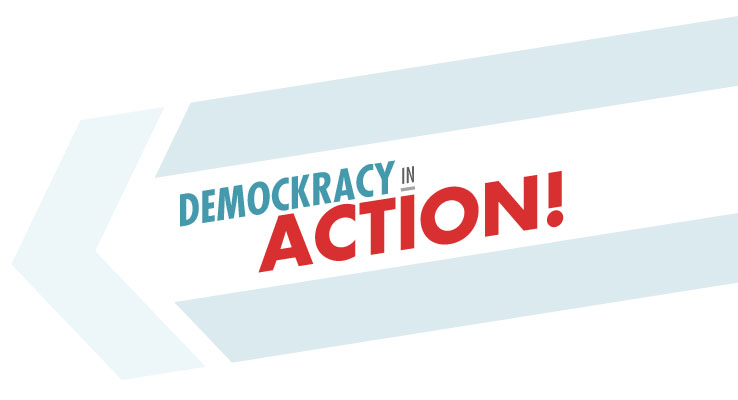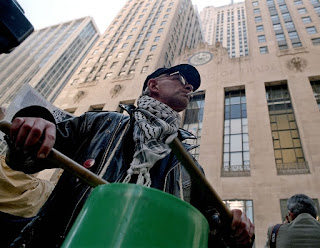Older protesters hold down the fort in the morning while their younger counterparts are in class.
Still, I found claims of it being "unorganized" or decentralized less than accurate. Motley facade notwithstanding, Occupy Chicago holds daily "general assemblies," complete with predetermined topics and agreed-upon rules for speaking, articulating opinions, and consensus-building. Its decision-making process is in consequence more fundamentally parliamentary than "direct-democratic"/mob-based (even if the protesters themselves would like to insist otherwise), with various factions and interests (e.g. eco-friendly vegans, pro-union protesters, &c.) cordially lobbying for support within and using the rules of the game. The absence of a corpus of permanent debaters and representatives is really the only signal distinction, though I suspect this has more to do with attendees having to juggle work and classes on the side.
Like Congress, these daily congregations are on average rather inane and repetitive, with plenty of opportunities for grandstanding for the sufficiently charismatic. True to parliamentary form, some decision-making invariably goes on behind closed doors, though the fruits of these strategy sessions eventually make their way before the public.
Elsewhere, there are "committees" responsible for sign making, IT upkeep, legal affairs, security and media relations, which arose more-or-less organically out of necessity as the protest grew in size and scope. Though Occupy Chicago lacks an identifiable personality at its helm, and so is, broadly speaking, "decentralized," these committees are staffed by recurring actors working shifts. Overall, the bureaucratization of discrete functions is not at all dissimilar from what one finds in government and the corporate world.
What distinguishes Occupy Chicago's organization is its pervasive haphazardness. Though the occupation is nearly a month old as of press time, its online fundraising arm is relatively hard to find, not to mention beset by difficulties pertaining to due diligence, which will no doubt frustrate soliciting the large donations necessary for the occupation's long-term survival and clout. Press and media relations exist on paper, but pale in comparison to the efforts of other activist groups, unions and coalitions, like Stand Up! Chicago, which organized the massive Columbus Day march on the Futures Industry Association. Events of questionable utility to Occupy Chicago's credibility and popularity, like a third-party discussion of The Communist Manifesto, are advertised without qualification or any subsequent efforts at damage control.
A good number of these problems could be attributed to the transiency and inexperience of the protesters themselves. Many are full-time college students and first-time activists who come in between or after classes. Older attendees have jobs and can only participate after work, or have families and children to look after. The vast majority of demonstrators are neophytes unaccustomed to the level of planning and organization necessary for any sustained political movement (though I should point out that they're learning quickly on the job). Even though they've quietly adopted many rather conventional solutions, an adolescent desire to reflexively reject external authority and advice is palpable, and is, in my estimation, probably the biggest factor behind the Occupy movement's steadfast refusal to be, in their eyes, co-opted by existing institutions.
To Occupy Chicago's credit, its proposed demands have been refreshingly specific compared to those found elsewhere, possibly as a consequence of its relatively small size (around a hundred protesters show up during peak hours), and the preponderance of similarly-minded, college-educated participants. This isn't to say that some points aren't naive and impracticable (see point three on their list). All of them are short on details, especially when it comes to implementation (though this is, I admit, a somewhat unfair expectation), but the entire enterprise does demonstrate more thought than all the drumming, chanting, and sign-holding would suggest.
The conclusion I've drawn from all of this so far is that Occupy Chicago is not nearly as radical or revolutionary as you might imagine or perhaps hope. Granted, there's the odd anarcho-syndicalist firebrand or first-year wannabe Bolshevik calling for the abolition of late-stage capitalism, but the people I spoke to were on the whole more concerned about redressing income inequalities, reducing poverty, finding a job (or keeping it), and rolling back corporate and monied interests in government. These goals and some of their core methods reveal to me a desire to restore rather than uproot America's legitimizing principles.
The protest's biggest tests are yet to come. City planning and the onset of winter conspire against the nascent movement's long-term survival. The sidewalks at the corner of LaSalle & Jackson cannot accommodate large gatherings, and the financial district is, quite frankly, not Chicago's most visible corner. In the absence of a commodious public space like Zuccotti Park and a more robust fundraising and outreach network, there's a distinct danger that Occupy Chicago will not survive the winter to return the following spring.
Despite my reservations, I must confess that seeing my contemporaries out voicing their opinions is ultimately a great source of encouragement. Beating drums out on the streets might not seem like much, but god knows that the current establishment is anything but an exemplar of excellence and justice.
Like Congress, these daily congregations are on average rather inane and repetitive, with plenty of opportunities for grandstanding for the sufficiently charismatic. True to parliamentary form, some decision-making invariably goes on behind closed doors, though the fruits of these strategy sessions eventually make their way before the public.
A general assembly meeting on October 4th. The meetings have since moved to the corner of Michigan & Congress due to increased attendance.
Elsewhere, there are "committees" responsible for sign making, IT upkeep, legal affairs, security and media relations, which arose more-or-less organically out of necessity as the protest grew in size and scope. Though Occupy Chicago lacks an identifiable personality at its helm, and so is, broadly speaking, "decentralized," these committees are staffed by recurring actors working shifts. Overall, the bureaucratization of discrete functions is not at all dissimilar from what one finds in government and the corporate world.
What distinguishes Occupy Chicago's organization is its pervasive haphazardness. Though the occupation is nearly a month old as of press time, its online fundraising arm is relatively hard to find, not to mention beset by difficulties pertaining to due diligence, which will no doubt frustrate soliciting the large donations necessary for the occupation's long-term survival and clout. Press and media relations exist on paper, but pale in comparison to the efforts of other activist groups, unions and coalitions, like Stand Up! Chicago, which organized the massive Columbus Day march on the Futures Industry Association. Events of questionable utility to Occupy Chicago's credibility and popularity, like a third-party discussion of The Communist Manifesto, are advertised without qualification or any subsequent efforts at damage control.
A good number of these problems could be attributed to the transiency and inexperience of the protesters themselves. Many are full-time college students and first-time activists who come in between or after classes. Older attendees have jobs and can only participate after work, or have families and children to look after. The vast majority of demonstrators are neophytes unaccustomed to the level of planning and organization necessary for any sustained political movement (though I should point out that they're learning quickly on the job). Even though they've quietly adopted many rather conventional solutions, an adolescent desire to reflexively reject external authority and advice is palpable, and is, in my estimation, probably the biggest factor behind the Occupy movement's steadfast refusal to be, in their eyes, co-opted by existing institutions.
Mark Banks (center), a member of Occupy Chicago's media arm, joins fellow protesters at Take Back Chicago, a coalition of unions and activists who marched on the Futures Industry Association's annual meeting on Columbus Day. Protesters from Occupy Chicago, though part of the coalition, carved out a distinct chunk of the plaza in front of the Chicago Board of trade for themselves.
To Occupy Chicago's credit, its proposed demands have been refreshingly specific compared to those found elsewhere, possibly as a consequence of its relatively small size (around a hundred protesters show up during peak hours), and the preponderance of similarly-minded, college-educated participants. This isn't to say that some points aren't naive and impracticable (see point three on their list). All of them are short on details, especially when it comes to implementation (though this is, I admit, a somewhat unfair expectation), but the entire enterprise does demonstrate more thought than all the drumming, chanting, and sign-holding would suggest.
The conclusion I've drawn from all of this so far is that Occupy Chicago is not nearly as radical or revolutionary as you might imagine or perhaps hope. Granted, there's the odd anarcho-syndicalist firebrand or first-year wannabe Bolshevik calling for the abolition of late-stage capitalism, but the people I spoke to were on the whole more concerned about redressing income inequalities, reducing poverty, finding a job (or keeping it), and rolling back corporate and monied interests in government. These goals and some of their core methods reveal to me a desire to restore rather than uproot America's legitimizing principles.
The protesters, many of whom are from private colleges, might be more privileged than a considerable number of Americans, but their demands reveal an understanding that the current crisis is far larger than themselves.
The protest's biggest tests are yet to come. City planning and the onset of winter conspire against the nascent movement's long-term survival. The sidewalks at the corner of LaSalle & Jackson cannot accommodate large gatherings, and the financial district is, quite frankly, not Chicago's most visible corner. In the absence of a commodious public space like Zuccotti Park and a more robust fundraising and outreach network, there's a distinct danger that Occupy Chicago will not survive the winter to return the following spring.
What will happen to them come winter?
Despite my reservations, I must confess that seeing my contemporaries out voicing their opinions is ultimately a great source of encouragement. Beating drums out on the streets might not seem like much, but god knows that the current establishment is anything but an exemplar of excellence and justice.










No comments:
Post a Comment